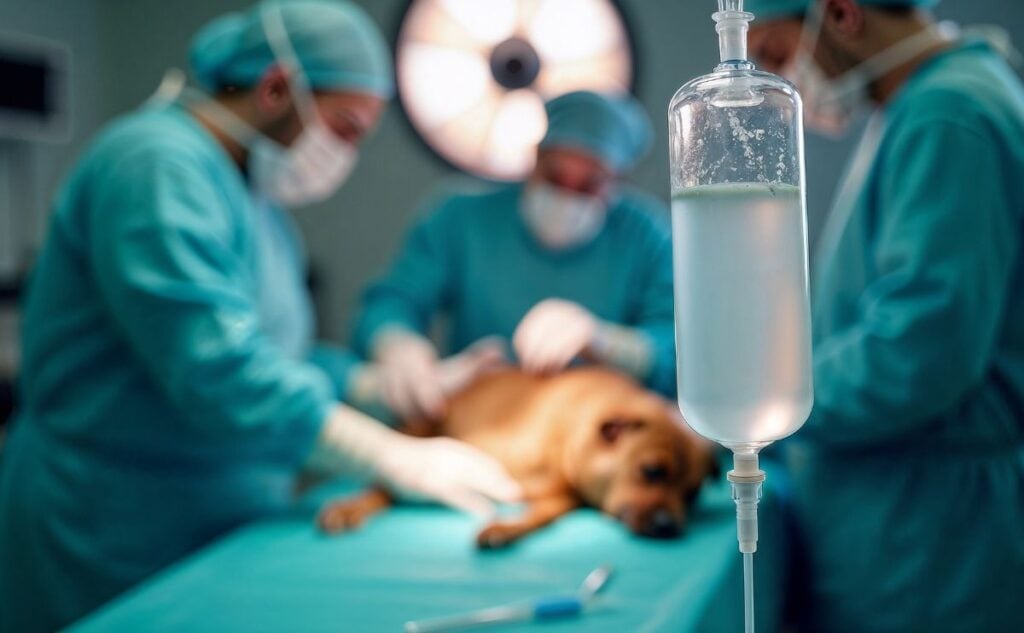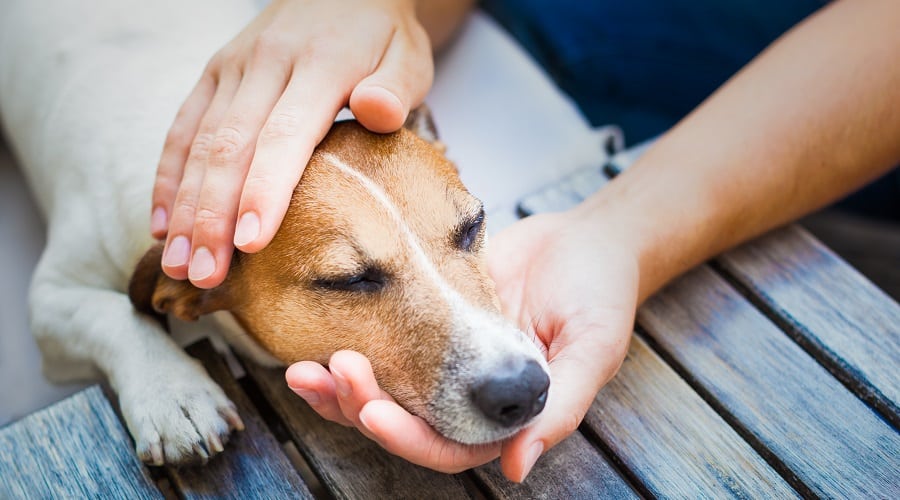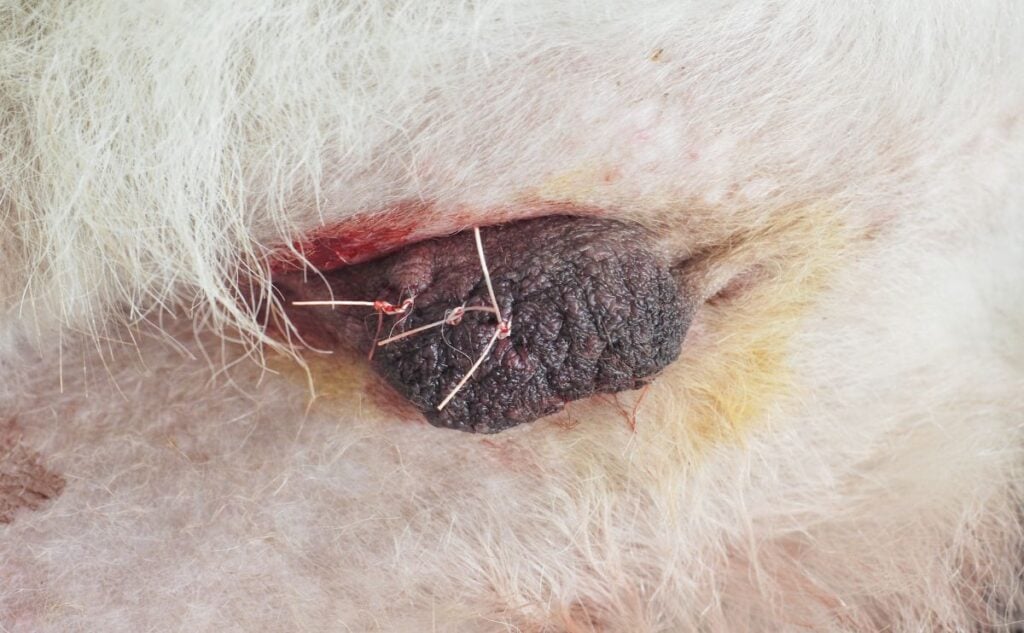Prostate Cancer In Dogs: Signs, Treatment, Prognosis & More
When you purchase through links on our site, we may earn a commission. Here’s how it works.
It’s the word all pet parents dread, the big ‘C.’ Many cancers can mimic other illnesses, and prostate cancer in dogs is no different. So, as scary as it is, a little knowledge will help you to spot worrying signs early on.
Table of Contents
Prostate cancer is cancer of the gland that sits at the neck (the exit) of the bladder in male dogs. It is an aggressive type of cancer, which tends to be both very fast-growing and quick to spread. Luckily, canine prostate cancer is rare.
The aggressive nature of prostate cancer in dogs makes prompt diagnosis even more important than usual. So, do you know the signs of prostate cancer in dogs?

Can Dogs Get Prostate Cancer?
The prostate is a small gland that sits at the neck of the bladder in male dogs. It produces some of the fluids present in semen (the fluid which carries sperm). Dogs can develop various conditions of the prostate, including the following. Fortunately, prostate cancer is estimated to affect less than 1% of dogs.
- Benign prostatic hyperplasia (BHP): BHP is common in entire (unneutered) dogs over the age of around six years. It is a harmless enlargement of the prostate gland driven by testosterone. However, it can cause annoying and painful symptoms for the dog, interfering with both defecating (pooing) and urinating (peeing).
- Prostatitis: This describes painful inflammation of the prostate gland, usually caused by a bacterial infection.
- Prostatic cysts: These are fluid-filled lumps, or pockets that develop within the prostate and cause similar symptoms to BHP.
- Prostate cancer: Although it is rare, dogs can get prostate cancer. It is mainly found in elderly dogs over 10 years old. Sadly, unlike BHP, it can’t be prevented by neutering.
While neutering doesn’t prevent prostate cancer in dogs, it can help prevent BPH, testicular cancer, and perianal tumors located around the anal area. Learn more about the benefits of neutering your pup and when it’s recommended.
Dog Prostate Cancer Symptoms
Many of the early symptoms of cancer are due to the tumor growing, placing pressure on the bladder and colon. The early symptoms of prostate cancer in dogs include:
- Straining to defecate
- Flatter, thinner feces
- Straining to urinate
- Blood in the urine
- Urinary incontinence
Signs of advanced prostate cancer in dogs include:
- Poor appetite
- Weight loss
- Lethargy
- Weakness and ataxia (wobbliness)
Sadly, prostate cancer quickly spreads to the surrounding bones. As things progress, dogs will develop back pain and/or abdominal (tummy) pain.

Dog Prostate Cancer Diagnosis
Your vet may be able to feel an enlarged prostate during a rectal exam, or they may suspect a prostate issue from your dog’s symptoms. They may recommend blood work, a urine sample, and some imaging, such as an ultrasound. A biopsy (sample) of the prostate can be taken to look for cancerous cells. This is done using a needle and syringe to suck out some cells and an ultrasound to guide the sampling. The alternative is using a catheter to ‘wash’ out some cells.
If your dog is diagnosed with prostate cancer, your veterinarian will recommend ‘staging.’ This means looking for evidence of spread to other areas of the body by sampling lymph nodes and further imaging, such as CT or MRI scans.
Dog Prostate Cancer Treatment
Unfortunately, there is no cure for prostate cancer in dogs. Treatment is aimed at keeping the dog comfortable, slowing the growth of the tumor and reducing the spread. The treatment plan would be tailored on a case-by-case basis to suit each pup and their pet parent. Treatment options include:

Surgery
Unfortunately, it is rarely possible to remove the whole tumor without causing significant damage to the urinary tract, leaving the dog with a poor quality of life. Even if removal is possible, the cancer has usually spread to other areas of the body by the time of diagnosis, meaning surgery would not be curative.
Sometimes, surgery can be used as a palliative measure to ‘de-bulk’ (reduce the size of) the tumor. This relieves some of the symptoms for a period of time. However, it will grow back. Other surgeries may be offered if the dog is having real difficulty passing urine, such as placing a stent.
Radiation
Radiation therapy of the prostate gland, affected lymph nodes, and/or bone can be used to relieve some of the symptoms.
Nonsteroidal Anti-Inflammatory Medication (NSAIDs)
These drugs act as pain relief and to reduce inflammation (swelling), and can sometimes help to prolong life expectancy in dogs with prostate cancer.
Chemotherapy
Again, chemotherapy cannot cure prostate cancer but may help to control the symptoms, especially when used alongside radiation or NSAIDs.
Palliative drugs
Other medications can be used to help improve symptoms, such as other forms of pain relief and stool softeners.
Often, a combination of these treatments is used. As impossible as the decision seems, remember that humane euthanasia is an option to consider too. If your pup is in pain and suffering, this is certainly the kindest option. Read our article on how to know when it’s time to put your dog down for some advice about this difficult decision.
Prostate Cancer In Dogs: Survival Rate
Unfortunately, because the cancer is so aggressive, most dogs only survive weeks to months following their diagnosis. Pet parents usually make the heartbreaking (but kind) decision to euthanize once the pain and symptoms aren’t controlled with treatment. So, prostate cancer in dogs life expectancy ranges from a matter of days to around six months.
If your dog is experiencing any of the symptoms listed here, see your veterinarian as soon as possible. If your dog is straining to pee and is not passing anything, this is a life-threatening emergency, no matter the cause. Remember, the earlier a diagnosis is made, the better.
Affording Expensive Veterinary Treatment
Diagnosing and treating cancer and other severe illnesses in dogs can cost thousands of dollars, making management cost-prohibitive for many owners — even when a prognosis is promising. However, having pet insurance can provide you and your pet a lifeline by covering a large portion of vet bills. Keep in mind, though, that it’s important to get a policy before your pup develops health problems. Otherwise, they are considered pre-existing conditions and likely won’t be covered. See my colleague’s expert reviews of the best pet insurance providers to learn more.




